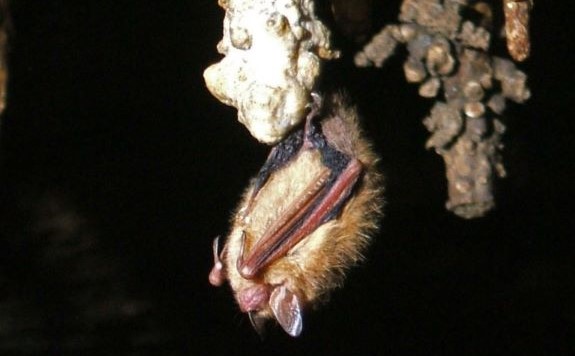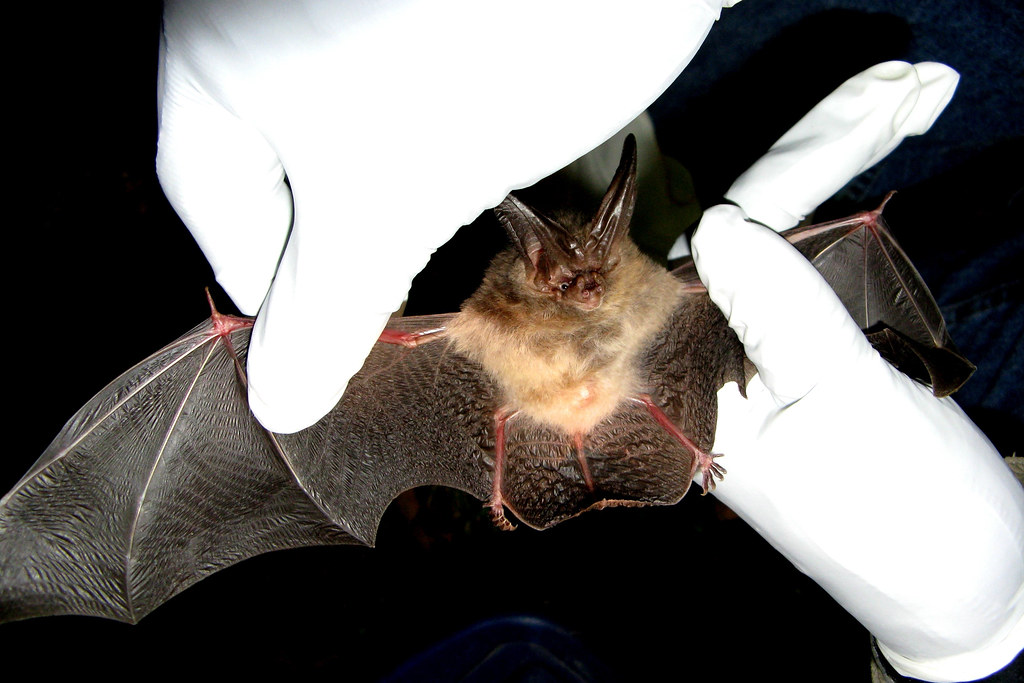
 Department of Conservation and Recreation
Department of Conservation and Recreation
Conserve. Protect. Enjoy.
 Department of Conservation and Recreation
Department of Conservation and Recreation
By Julie BuchananPosted October 26, 2020

Tricolored bat. Photo by Phil Lucas.
The final week of October is Bat Week, a time to recognize the important ecosystem services that bats contribute worldwide.
These winged mammals live almost everywhere on Earth, and while you may never see them, there’s a good chance they live near you.
Even though Bat Week falls around Halloween, bats are not to be feared. The 1,400 species of bat around the world provide a wealth of services from insect control to pollination. They are an essential and beneficial part of natural ecosystems.
Virginia is home to 16 bat species, including the newly arrived Brazilian free-tailed bat (Tadarida brasiliensis), a recent arrival due to the warming climate. Virginia even has its own state bat: the Virginia big-eared bat (Corynorhinus townsendii virginianus), a federally endangered species.
 Virginia big-eared bat. Photo by JH Fagan/Virginia Department of Conservation and Recreation.
Virginia big-eared bat. Photo by JH Fagan/Virginia Department of Conservation and Recreation.
Nearly a quarter of bats are considered critically endangered, endangered or vulnerable, according to Bat Conservation International. The disease white-nose syndrome appeared in New York in 2006 and through 2012 had killed nearly 7 million bats in the Eastern United States and Canada, including tens of thousands in Virginia. Habitat loss and climate change are other major threats.
Bats are particularly vulnerable to threats posed by disease and habitat loss. Unlike most mammals their size, individual bats can live up to several decades with most species only producing a single offspring per year.
“Even without additional threats, it will take decades for populations to recover from the white-nose syndrome epidemic,” said Wil Orndorff, karst protection coordinator with the Virginia Department of Conservation and Recreation. “Now more than ever, people need to value and respect bats.”
Recent events have served to reinforce bats’ bad reputation. SARS Coronavirus 2, the virus causing COVID-19, is believed to have originated in China from a species of horseshoe bat, distant relatives to North American bat species. Bats are known to carry rabies, and bat species in other parts of the world have been linked to other zoonotic diseases.
However, if bats are treated with respect and left alone, the health risk they pose to humans is small when compared to the huge benefit they provide in controlling insect pests.
DCR is involved in many bat protection efforts with partners such as the Virginia Department of Wildlife Resources, faculty and students from Radford University and Virginia Tech, landowners, and volunteers from the conservation and caving communities. Scientists with DCR’s Natural Heritage Program monitor known bat populations and search for undocumented roosts and hibernacula to assist in conservation efforts to benefit bats.*
DCR’s work also involves a range of activities to protect bat habitat, including the acquisition and management of natural areas used by bats, the installation of gates at cave entrances to limit human access impacts, and education to cave owners and the caving community.
“While bats, being nocturnal, are out of sight to most of us, they should not be out of mind,” said Jason Bulluck, director of the Virginia Natural Heritage Program. “They are a valuable part of Virginia’s native biodiversity and critical to balancing insect populations. Most importantly, bats help to control large population outbreaks of non-native insects, which pose enormous threats to agricultural crops.
“Efforts to protect bats and their habitats help ensure their free ecosystem services persist, for biodiversity and human well-being.”
More about bats
Virginia Natural Heritage Karst Program
Virginia Department of Wildlife Resources
U.S. Fish and Wildlife Service – Virginia Big-Eared Bat Fact Sheet
White-nose Syndrome Response Team – Forest Management and Bats
*Due to concerns over the human handling of bats during the novel coronavirus pandemic, DCR and DWR have suspended work that involves direct contact with bats.
DCR Karst Protection Coordinator Wil Orndorff and Natural Heritage Program Director Jason Bulluck contributed to this article.
Categories
Natural Heritage

